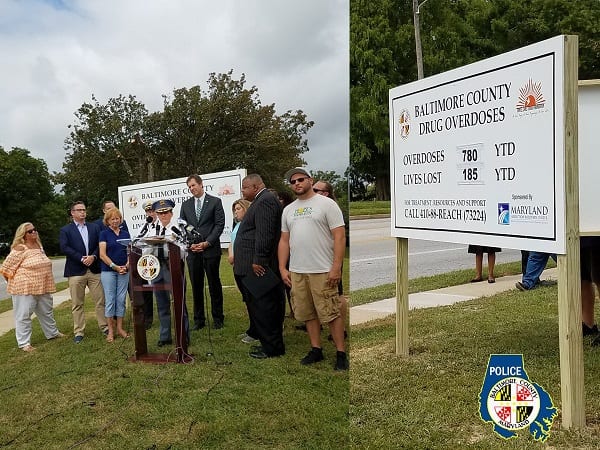TOWSON, MD – Baltimore County Executive Johnny Olszewski has announced the placement of overdose awareness signs around the county in an effort to shine light on the opioid epidemic and reduce the stigma often associated with addiction.
Strategically placed in five, high-visibility locations around Baltimore County, the signs will display the total number of overdoses and fatal overdoses in the county so far this year.
“There’s not a community in our County that hasn’t been touched by the disease of opioid addiction and we have to do everything within our power to raise awareness, increase access to services and save lives. These signs will be a stark reminder that this crisis persists and that we have a responsibility to help our sons, daughters, mothers, fathers, neighbors and friends who are struggling,” Olszewski said.
The signs were created with support from the Daniel Carl Torsch Foundation and sponsors identified by foundation Executive Director Toni Torsch. Torsch created the foundation following the death of her son, Daniel, from a heroin overdose. The foundation works to raise awareness of opioid addiction and overdose, helps individuals find treatment resources and provides training for individuals to use the overdose-reversal drug naloxone.
“I applaud the Torsch Foundation for partnering with the County to provide awareness and education of overdose death statistics,” said Dr. Gregory Wm. Branch, Director of the Baltimore County Department of Health and Human Services. “Anyone who is facing an opioid addiction or knows someone who is, should reach out and prevent another untimely death by calling our REACH Helpline, 410-88-REACH (410-887-3224).”
Each month, the Baltimore County Police Department will update the numbers displayed on the signs, which will be located at the Public Safety Building in Towson, as well as the Dundalk, Pikesville, White Marsh, and Woodlawn precinct buildings.
“In my very first meeting with newly-elected County Executive Olszewski, I asked for help breaking a bureaucratic logjam that prevented these signs from going up. He delivered. This is one part of a more robust strategy toward reducing and eliminating opioid abuse,” said Councilman David Marks.
Olszewski has taken a number of critical steps in the effort to combat the opioid epidemic. As recommended by his transition team, he included funds in his first budget to create an Opioid Strategy Coordinator position to guide strategy across agencies and ensure a cohesive, comprehensive response.
In addition, he named an Opioid Response Working Group to engage county residents and stakeholders, examine data, assess the county’s current efforts and make recommendations for how the county can continue to ramp up its efforts to address addiction and overdose. The working group will release its draft report for public comment in the coming weeks.
More in the video below.
Do you value local journalism? Support NottinghamMD.com today.

